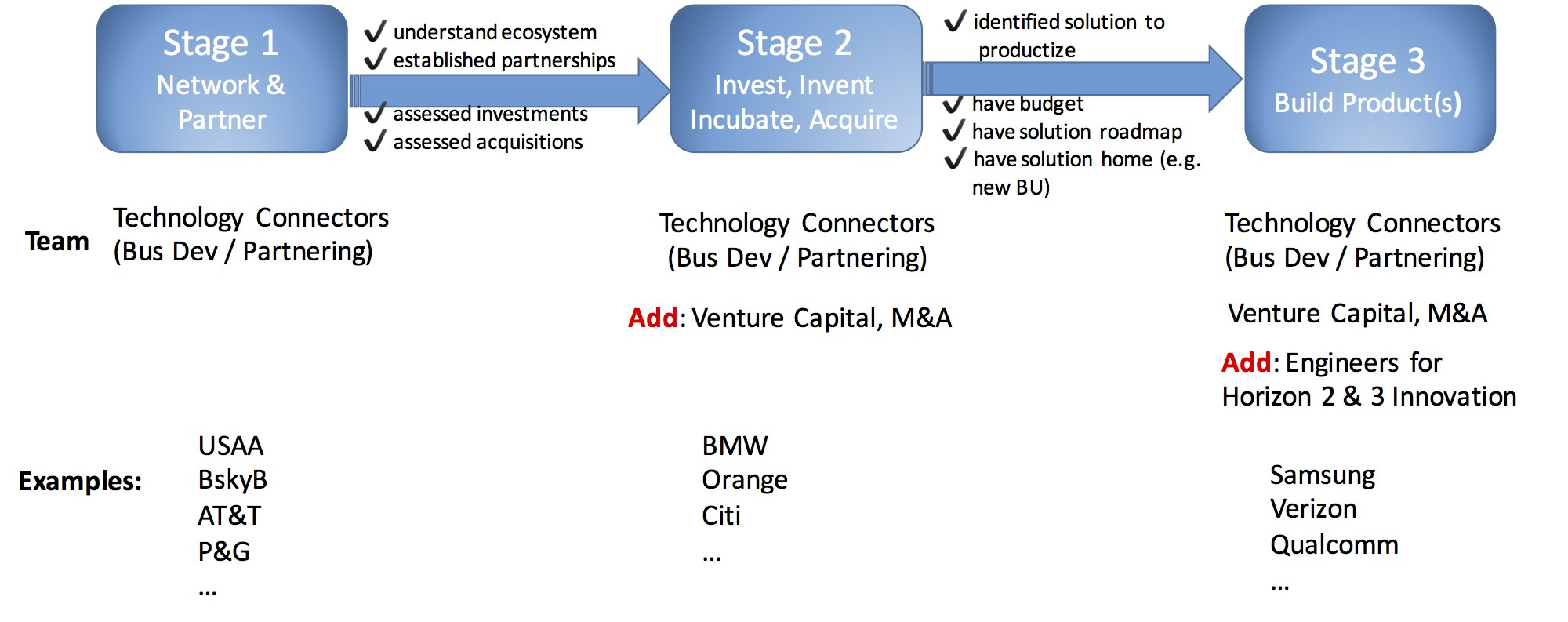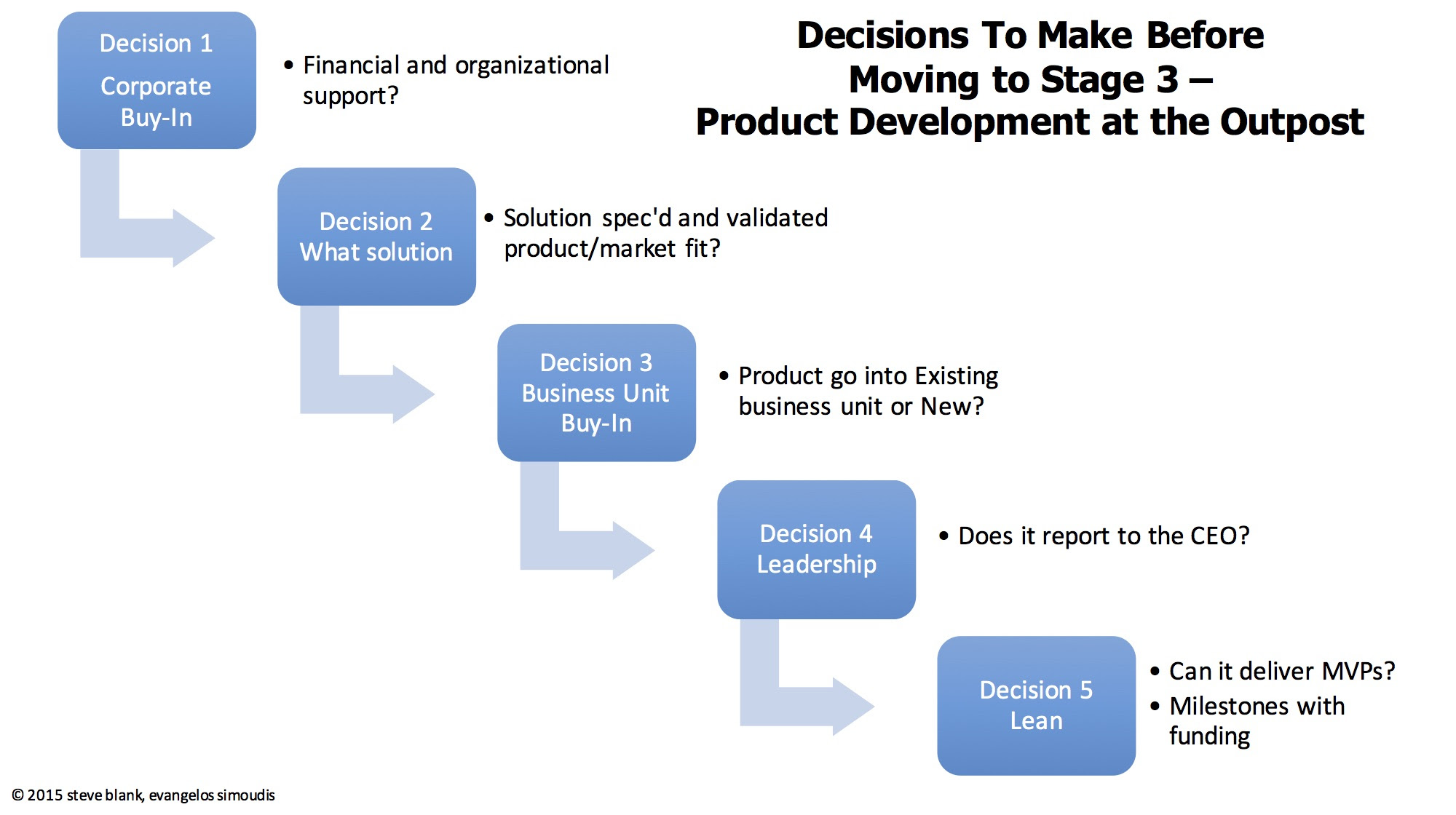If your company has decided to set up an innovation outpost (see our last post on how to make that decision), how do you actually do it? How do you staff it? What should the team in the outpost be doing day-to-day? In what order?
Here’s a step-by-step guide that will answer all of those questions.
Successful innovation outposts typically develop over a period of time in three stages. In the first stage, the outpost focuses on networking and partnering in the innovation cluster where it is based (i.e. Silicon Valley, Boston). In the second stage, it moves into investing, inventing, incubating, and acquiring technologies and companies. In the third stage, it focuses on building product(s). Each stage needs a clearly defined set of objectives and the right team to match those objectives.
Stage 1: Networking and Partnering – the Technology Connectors
As the eyes and ears of the parent corporation, a new innovation outpost’s first priority is to “sense” innovations by actively engaging with the innovation cluster. The outpost is on the lookout for innovations that:
- Could become threats that could lead to the disruption of the corporate parent.
- Could allow the corporation to be disruptive by entering adjacent markets to the ones it currently serves.
- Could create and introduce new and disruptive products and/or services for new markets.
To make this happen, the outpost’s first employees must be technology connectors – people who understand the parent corporation’s strategy and can execute it tactically.
The technology connectors need to start with a deep understanding of:
- One or two big strategic problems the corporation wants the outpost to solve. For example, BASF wanted to keep pace with university R&D in inorganic materials and biosciences.
- Innovation areas the corporation is interested in. For example, the Silicon Valley outposts of automakers like Mercedes and BMW and automotive parts suppliers like Delphi are focused on keeping pace with self-driving car technology.
These priorities have been identified by earlier planning work at the senior management level. (see the previous post.)
Next, tactically the outpost needs to engage with the innovation cluster to figure out how connecting the corporation to specific resources can solve the 1 or 2 problems and/or provide data in the areas the corporation needs. This means the outpost needs to identify and connect with:
- Investors
- Academics, consultants, and incubators
- Startups, entrepreneurs, and management teams
It needs to take what it learns and regularly update the corporate engineering, strategy, VC groups, and business unit heads on technology and market shifts.
In addition to getting plugged into the ecosystem’s network, the first role of the outpost is to partner. These partnerships may take the form of Proof of Concept projects with startups, getting to know VC firms and their portfolios, and getting familiar with university groups doing research in the established strategic problems. (The outpost may invest in a few startups in this stage, but that’s not the goal.)
For example, one of the big strategic problems a corporation may want its outpost to solve is to connect the company to the leading PhD and faculty in specific departments at Stanford and Berkeley. A Stage 1 outpost could partner with universities to set up a “Post Doc” center focusing on the strategic problem.
It’s important to establish the ground rules for these partnerships, recognizing that working with startups requires two-way value exchange. Companies and their outposts must be willing to share their knowledge, data, and technology with startups and introduce them to their networks. In exchange, the startups provide companies with their disruptive ideas, technologies, and business models.
(Companies unwilling to empower their outposts with the ability to exchange data with startups have set up the outpost for failure.)
Therefore, the profile of the initial team to staff an innovation outpost should be a technology-savvy business development group. These Technology Connectors will have deep business development (partnering) experience so that they can network broadly within the startup ecosystem with entrepreneurs, startup management teams, venture investors, and other intermediaries.
Companies often initially staff their innovation outpost with a venture investing group. This is not the the optimal way to start. Corporate VC needs to be part of an innovation investment portfolio with a mix of incubate, invest, and acquire. (Time horizons for return on investment from a VC investment may be 7+ years, ROI from the acquisition of an earlier stage company, 4-5 years, and the ROI from acquisition of a mature company, 2-3 years.) Until a company has enough data from its Stage 1 innovation outpost, starting an innovation outpost with corporate VC often results in “ready, fire, aim.”
Finally, it is essential that all of the outpost team members are well-respected and networked within the corporation so that their recommendations can be heard and adopted by the CEO, board, and business unit (BU) executives. There’s nothing more wasteful than having an innovation outpost reporting on disruption heading for the company’s core business (autonomous vehicles, machine learning, virtual reality, cloud, Internet of Things, et al.) when no one at headquarters wants to listen. For all these reasons, the team must consist of a small group of individuals reporting to a single leader, who in turn reports to the CEO.

Figure 1: Three Stages of Corporate Innovation Outposts
After its initial success in “sensing” the innovation cluster and partnering, the outpost team has to assess how to “respond” to these threats and opportunities. Should the corporation invest, invent, incubate, or acquire? The answer to this question sets up the outpost for Stage 2 of its growth.
Stage 2: Investing/Inventing/Incubating/Acquiring – Adding VCs and Acquirers
In Stage 1, the innovation outpost was essentially an “early warning” and innovation identification vehicle for the company. For the majority of corporations, having this stage may be sufficient to solve the 1-2 big strategic problems they’ve identified. However, the company may decide to expand the responsibilities of the innovation outpost to invest, invent, incubate, acquire, or partner.
In Stage 2, the corporation adds venture capital and/or mergers-and-acquisition teams to provide these functions. Examples of Stage 2 outposts include BMW’s Silicon Valley development group, working on self-driving vehicle technologies, while their venture group has been making investments in companies like ChargePoint and Nauto. Another example is Qualcomm, which invests around robotics and incubates in collaboration with Techstars.
Before deciding to move to Stage 2, the CEO, exec staff, and operating heads should revisit whether investing, inventing, incubating, or acquiring startups can make an important contribution to the achievement of their corporate innovation goals. If the company needs immediate results, then identifying acquisitions, particularly of more mature companies, should be the priority. If the company has a longer term horizon, then investing or incubating should be considered. At times this means that the company must be willing to share knowledge, data, technology, and processes with these startups.
In Stage 2, the corporation is starting to invest serious time and money into the outpost. Therefore, it’s important to have a permanent executive running the innovation outpost and reporting to the company CEO. Appointing outpost leadership as a temporary assignment leads to weak relations between the innovation ecosystem and the innovation oiutpost and increases the risk of failure.
Stage 3: Productizing the Solution to Corporate Problems
In Stage 3, an innovation outpost creates a product development group to bring to market the solution(s) — a product or service — to the challenge(s) that led to the establishment of the outpost in the first place.
Examples of Stage 3 outposts include Verizon (which has been developing its mobile video player, infrastructure, monetization/advertising, and analytics product(s) in Silicon Valley; Walmart which has acquired, invested, and been implementing its commerce platform in its San Bruno center; and GE, which has created a software development organization around big data, and its Predix platform, which works with GE units that focus on big data.
Before moving to Stage 3 and building products, answering these five questions can save a ton of resources, time, and frustration:
- Do we have corporate buy-in to build a product?
- This is where the rubber meets the road. Is corporate willing to give both the financial and organizational support for product development in the innovation cluster?
- Is the outpost product officially part of a corporate innovation portfolio?
- What solution are we productizing?
- Do we have an initial definition of the solution, have gotten out of the building and validated product/market fit, and have a first pass of a validated business model.

- Where in the company will this new solution fit?
- Do we have buy-in from existing business units for products that fit existing business models (Horizon 1) or extended business models (Horizon 2).
- Disruptive solutions with new business models (Horizon 3) require an a priori agreement on the criteria for creating a new business unit (revenue, profits, value-added, etc.)
- Who will lead this new effort?
- Four excellent examples of this transition include BMW’s brand, Verizon’s online video business unit, Telefonica’s Open Future business unit, and Samsung’s Connected Home business unit. Google’s Car organization is in the process of making this transition. Google just named the organization’s leader.
- Do we have a Lean Startup Methodology in place?
- Can we deliver minimum viable products?
- Do we have a go/no process – agreed with corporate – that ensures follow-on funding and deployment?
At the end of Stage 3, the outpost is ready for new challenges, and the innovation cycle repeats.
Lessons Learned
- Does your Stage 1 outpost have Technology Connectors as its key leadership/staff?
- Does your Stage 2 outpost have a permanent executive running the innovation outpost?
- Do they report to the company CEO?
- Does your Stage 3 outpost have corporate buy-in for productization?
Steve Blank is a retired serial entrepreneur-turned-educator who has changed how startups are built and how entrepreneurship is taught. He created the Customer Development methodology that launched the lean startup movement, and wrote about the process in his first book, The Four Steps to the Epiphany. His second book, The Startup Owner’s Manual, is a step-by-step guide to building a successful company. Blank teaches the Customer Development methodology in his Lean LaunchPad classes at Stanford University, U.C. Berkeley, Columbia University, UCSF, NYU, the National Science Foundation and the I-Corps @NIH. He writes regularly about entrepreneurship at www.steveblank.com.
Evangelos Simoudis is founder and managing director of Corporate Innovation Ventures. Evangelos has worked in Silicon Valley as a technologist, entrepreneur, corporate executive, and VC. Today, he advises global corporations on startup-driven innovation and big data strategies, and invests in early-stage startups working on big data applications. He writes and speaks frequently on corporate innovation, big data, cloud computing, and digital marketing platforms. In 2014, he was named a Power Player in Digital Media, and in 2012 as a top investor in online advertising. He writes regularly on these topics at www.corporateinnovation.co.


